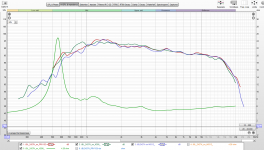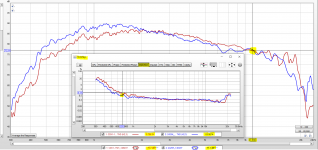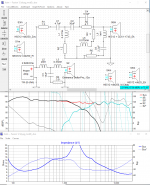sheepie,
Sorry, no links or pics.
Also, it's most likely a just huge time suck with no predictable ( good ) outcome ( so it's probably best to stand-down on that suggestion of adding stuff in the throat ).
- I just spent 15 mintes with plumbers putty doing exactly what I had suggested .
The trend was clear >>> I was only making the response worse ( in higher HF areas ) with no meaningful contributions happening towards the goal of filling the 2K trough.
- Trending badly is a very good reason to stop.
FYI, I also tried 30 ppi foam ( 1.25" deep ) filling the "tube".
Here's what's achievable on that JBL waveguide ( as well as 2 other horns ) when one uses a driver with a low Fs and which has a builtin threaded snout.
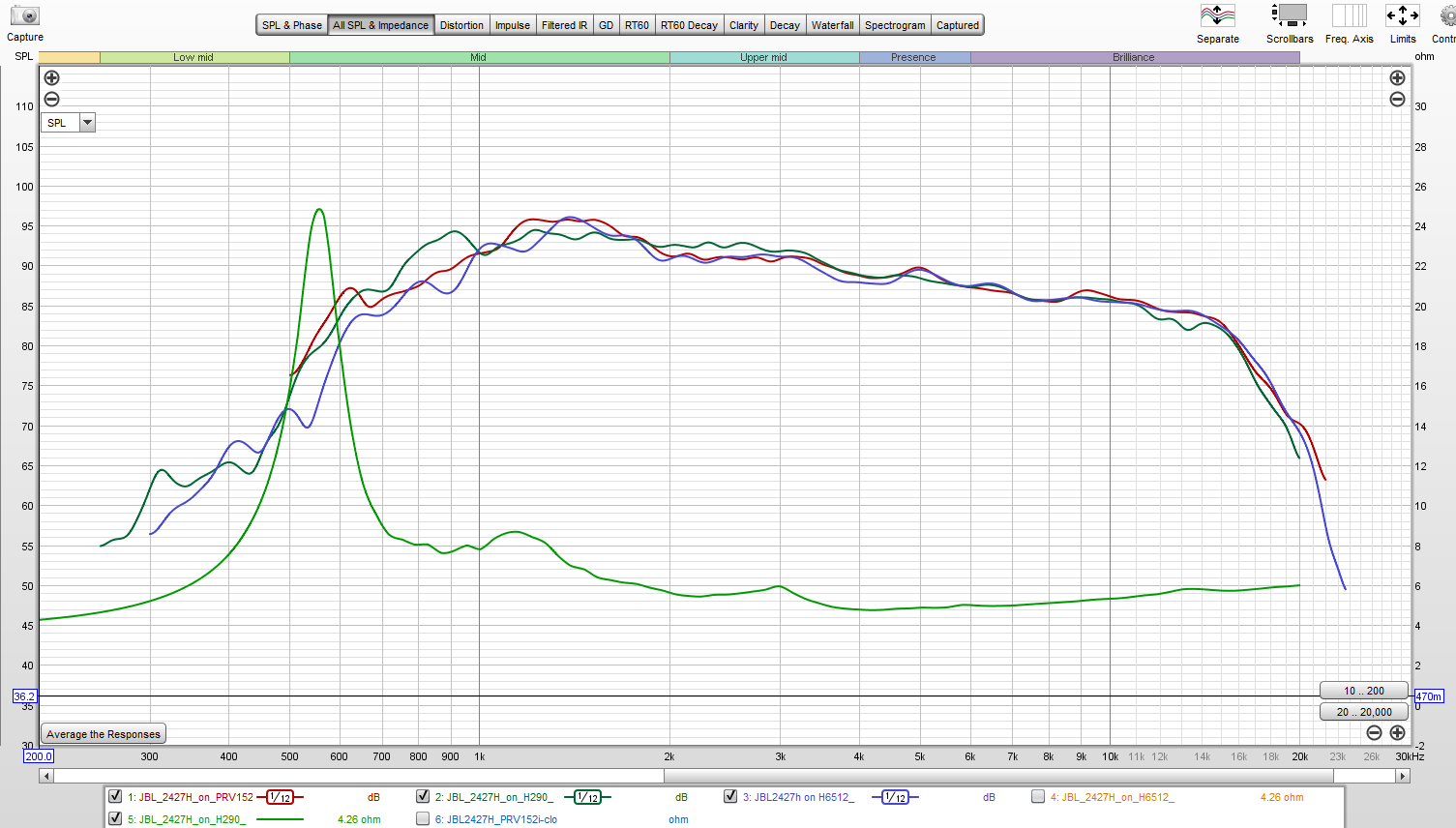
This same driver on 3 different waveguides produces ( statiscally ) just about the same response.
The "tangle of traces" makes it very hard to see but the H290 does arguably have the most linear response ( fwiw ).
- The traces are from 2016 thru to 2018 .
Similarly, here's a trace of a JBL 2425H ( + a Celestion ) on one of my 18Sound 1464XT horns.
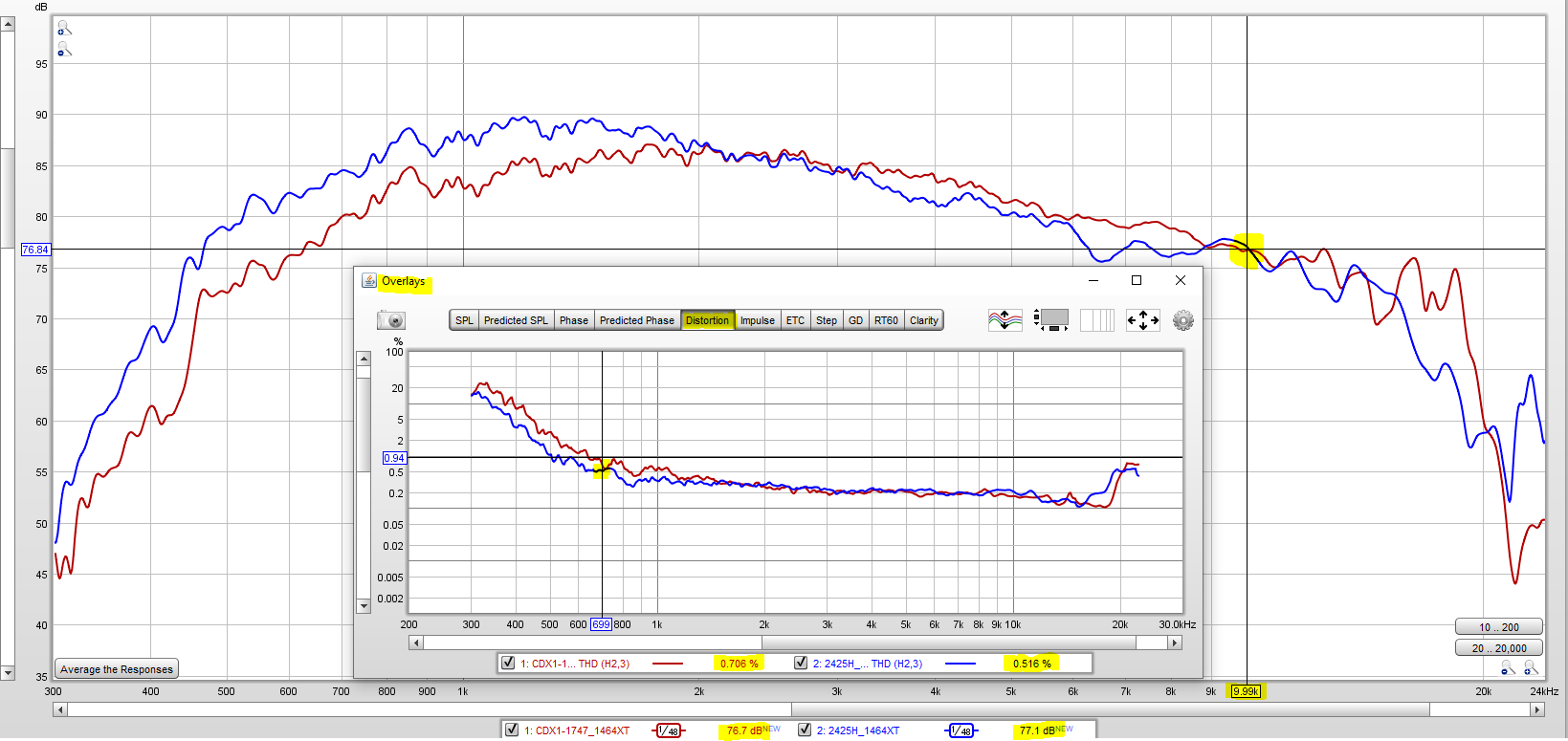
Both drivers perform equally well on this waveguide and would afford a 700hz ( ish ) crossover point ( for home use ) . Check out the distortion specs.
🙂
Ya know, just to muddy the waters.
Sorry, no links or pics.
Also, it's most likely a just huge time suck with no predictable ( good ) outcome ( so it's probably best to stand-down on that suggestion of adding stuff in the throat ).
- I just spent 15 mintes with plumbers putty doing exactly what I had suggested .
The trend was clear >>> I was only making the response worse ( in higher HF areas ) with no meaningful contributions happening towards the goal of filling the 2K trough.
- Trending badly is a very good reason to stop.
FYI, I also tried 30 ppi foam ( 1.25" deep ) filling the "tube".
Here's what's achievable on that JBL waveguide ( as well as 2 other horns ) when one uses a driver with a low Fs and which has a builtin threaded snout.
This same driver on 3 different waveguides produces ( statiscally ) just about the same response.
The "tangle of traces" makes it very hard to see but the H290 does arguably have the most linear response ( fwiw ).
- The traces are from 2016 thru to 2018 .
Similarly, here's a trace of a JBL 2425H ( + a Celestion ) on one of my 18Sound 1464XT horns.
Both drivers perform equally well on this waveguide and would afford a 700hz ( ish ) crossover point ( for home use ) . Check out the distortion specs.
🙂
Ya know, just to muddy the waters.
Attachments
Or is there simply a better coupling waveguide <-> B&C DE250, that I should consider? I mean: I am investing some money into this build and if this specific waveguide poses such a response problem and another maybe not, I would consider changing.
The SEOS 15 works great with the DE250 down to 1k. Not super easy to find them for sale though. DIYSG has them but not usually listed for sale on their own.
It really depends on how much it is just a resonance. You can equalise a resonance, but you need to confirm how it fares in directivity to see whether this is possible. I would not be relying on Vituixcad defaults to determine this.Hi Allen. What would you suggest to fix it?
If I use two notches and allevate the band, scrape both of the peaks both lower and higher, the dip is neglible and it at least does "look" good simulated. Don't know about directivity: Vituixcad says it is okay, but meassurements will only take place after new year. Another/better idea?
Hey Allen! EQing is interesting. My room has the acoustics of a can and I will, if at all, only provide very decent treatment. Its still a living room, the only one we have, cannot afford ugly panels all over the place. So I was thinking of getting some affordable Ultracuve-ish device sometime.
It's quite clear that I cannot rely on Vituixcad alone. Also, the ditch between 1,5 kHz and 3,5 kHz is already latent in the free air/no-waveguide measurements of the DE250. Although way less pronounced.
I did write an E-Mail to the distributor to ask if he can provide the Celestion CDX1-1448 instead of the B&C, lets see. Sadly, there is very little available data on this device. I found a test on audioexpress Celestion CDX1-1447 Compression Driver with H1-7050 “No Bell” Horn | audioXpress and that's about it.
What do you think about the decay plots? It does seem a bit worse to me than the B&C's, or am I getting this wrong?
It's quite clear that I cannot rely on Vituixcad alone. Also, the ditch between 1,5 kHz and 3,5 kHz is already latent in the free air/no-waveguide measurements of the DE250. Although way less pronounced.
Well, I can't see the ground anyway, so why bother?Ya know, just to muddy the waters.
I did write an E-Mail to the distributor to ask if he can provide the Celestion CDX1-1448 instead of the B&C, lets see. Sadly, there is very little available data on this device. I found a test on audioexpress Celestion CDX1-1447 Compression Driver with H1-7050 “No Bell” Horn | audioXpress and that's about it.
What do you think about the decay plots? It does seem a bit worse to me than the B&C's, or am I getting this wrong?
Last edited:
sheeple,
Is there really a CDX1-1448 ? ( if so I'd still stick with the larger diaphragm versions ).
I know there's a CDX1-1748 ( which has the same size diaphragm as the de250 as well as has a diaphragm made of polyimide >> which is harder than PETP // Mylar ).
If doable, try out the 1748 or the CDX1-1746 ( which is the Mylar diaphragmed version ).
QSC uses the PETP // Mylar versions of the CDX1-1745 in their PA boxes and they sound very very good.
🙂
Is there really a CDX1-1448 ? ( if so I'd still stick with the larger diaphragm versions ).
I know there's a CDX1-1748 ( which has the same size diaphragm as the de250 as well as has a diaphragm made of polyimide >> which is harder than PETP // Mylar ).
If doable, try out the 1748 or the CDX1-1746 ( which is the Mylar diaphragmed version ).
QSC uses the PETP // Mylar versions of the CDX1-1745 in their PA boxes and they sound very very good.
🙂
Something got mixed up down the googling-line. I was looking for CDX1-1748 (screw-mounted 1747) measurements and how they compare to DE250.
Found this on the Celestion Distortion in loudspeakers | Page 7 | Audio Science Review (ASR) Forum (and the following page Distortion in loudspeakers | Page 8 | Audio Science Review (ASR) Forum), but I cannot really interpret and do not know comparison. Your distortion graph did look quite a bit better.
If Mylar is softer than polyimide, wouldn't I loose even more high frequency definition?
Found this on the Celestion Distortion in loudspeakers | Page 7 | Audio Science Review (ASR) Forum (and the following page Distortion in loudspeakers | Page 8 | Audio Science Review (ASR) Forum), but I cannot really interpret and do not know comparison. Your distortion graph did look quite a bit better.
If Mylar is softer than polyimide, wouldn't I loose even more high frequency definition?
Last edited:
If Mylar is softer than polyimide, wouldn't I loose even more high frequency definition?
Maybe in theory but that doesn't seem to be borne out in practice .
Both QSC ( Pro ) and DIYSG use the Mylar diaphragms in the Celestion drivers that they implement in their products .
I honestly can't tell the difference between a 1745 and a 1747 ( at home listening levels ) when the crossover point is above 1500hz.
The 1747 does go a bit lower ( likely due to the diaphragm being a bit more pistonic/stiffer at the lowest range .
Distortion specs can be really misleading // I make mine at home listening levels ( I never listen above 80db ) .
Distortion is quite inaudible to me until it gets past more than 3% ( 3rd HD ) .
I mostly have a quick look at the distortion profile of a driver to make sure it's diaphragm is properly installed//centered ( when it's not, the distortion traces will typically display this as the odd order harmonics being elevated above the 2nd HD in random regions ) .
🙂
Comparing mylar to polyimide is an option too much for now with so little experience on my side.
But the thing I would like to understand is: Can a screw-mounted compression driver ever compete with a bolt-on version? Or does it not always and necessarily fall behind, because there is incorrect transmission 'built in', with this additional distance between diaphragm and the horn? This may be more pronounced with an adapter, because the mouth of the driver is effectively down a straight tubing, whilst a genuine screw-on driver may benefit from a particular tapering. But a flange mounted compression driver will always just sit at the mouth of the horn and never introduce this problem into the system at all. So it should always be the first option?
I have two options: 1) Spending additional money on a new bolt-on horn pair or 2) staying with the screw-on horn I already have, 2b) maybe changing to a screw-mounted driver, or 2a) simply going down the path with the adapter already ordered.
If the answer to my above question is the insinuated, I would consider loosing more money, because it is 'right' then. I do not like built-in stupidities. But perfectionism sometimes kills a project, too.
But the thing I would like to understand is: Can a screw-mounted compression driver ever compete with a bolt-on version? Or does it not always and necessarily fall behind, because there is incorrect transmission 'built in', with this additional distance between diaphragm and the horn? This may be more pronounced with an adapter, because the mouth of the driver is effectively down a straight tubing, whilst a genuine screw-on driver may benefit from a particular tapering. But a flange mounted compression driver will always just sit at the mouth of the horn and never introduce this problem into the system at all. So it should always be the first option?
I have two options: 1) Spending additional money on a new bolt-on horn pair or 2) staying with the screw-on horn I already have, 2b) maybe changing to a screw-mounted driver, or 2a) simply going down the path with the adapter already ordered.
If the answer to my above question is the insinuated, I would consider loosing more money, because it is 'right' then. I do not like built-in stupidities. But perfectionism sometimes kills a project, too.
Last edited:
@Shepple:
Nothing is written in stone but you will likely encounter fewer problems if you go to the bolt on type of driver. There are much more waveguide/horn options for bolt on. I used econowave d220ti, DE250-8 in PT WG back in 2011 and learned a lot but now i wouldn't use it if high performance is what i was after. I've used DE500-8 and few others but now i'm settled with dfm2535 and B-52 waveguide (bought while it was available).
Perfectionism is hard to achieve with CD/WG combos even if you have near perfect drivers. You'll have to do a hell of a job with finding the right frequency to crossover. Large acoustic center offset at Z axis will kill good phase response on any other axis but optimised one, so you have to play with frontal lobe quite a bit to get good phase and frequency response 3-5m distance. DSP makes that part easier but only at that one axis. Physicaly adjusting the offset should be a must but that means that waveguide has to be mounted on top of a midwoofer cabinet to be able to align the acoustic centers. Acoustic center for CD in WG is much behind the woofer acoustic center (usually between 10-13cm) so for perfect alignment wg will be sticking out in front of front baffle plane (and that can be a bit ugly). That large surface will inevitably lead to difraction for midwoofer usually crossed at over 1kHz so you have to find the material to dampen back of the waveguide that will to the job of absorbing the sound from midwoofer effectively. Then there is edge diffraction with waveguides that are made for mounting in cabinets (like 99.9% of them). So you have to make roundovers to minimize the effect on measurable response. Roundovers tend to make vertical C to C distance larger so the crossover has to be lower which, in turn can stress the driver.
Yup, perfectionism can kill a project 🙂
Nothing is written in stone but you will likely encounter fewer problems if you go to the bolt on type of driver. There are much more waveguide/horn options for bolt on. I used econowave d220ti, DE250-8 in PT WG back in 2011 and learned a lot but now i wouldn't use it if high performance is what i was after. I've used DE500-8 and few others but now i'm settled with dfm2535 and B-52 waveguide (bought while it was available).
Perfectionism is hard to achieve with CD/WG combos even if you have near perfect drivers. You'll have to do a hell of a job with finding the right frequency to crossover. Large acoustic center offset at Z axis will kill good phase response on any other axis but optimised one, so you have to play with frontal lobe quite a bit to get good phase and frequency response 3-5m distance. DSP makes that part easier but only at that one axis. Physicaly adjusting the offset should be a must but that means that waveguide has to be mounted on top of a midwoofer cabinet to be able to align the acoustic centers. Acoustic center for CD in WG is much behind the woofer acoustic center (usually between 10-13cm) so for perfect alignment wg will be sticking out in front of front baffle plane (and that can be a bit ugly). That large surface will inevitably lead to difraction for midwoofer usually crossed at over 1kHz so you have to find the material to dampen back of the waveguide that will to the job of absorbing the sound from midwoofer effectively. Then there is edge diffraction with waveguides that are made for mounting in cabinets (like 99.9% of them). So you have to make roundovers to minimize the effect on measurable response. Roundovers tend to make vertical C to C distance larger so the crossover has to be lower which, in turn can stress the driver.
Yup, perfectionism can kill a project 🙂
Last edited:
Maybe I don't understand your point, but it should be no problem to achieve any phase relationship on the listening axis.Large acoustic center offset at Z axis will kill good phase response
sheepie,
Similarly, here's a trace of a JBL 2425H ( + a Celestion ) on one of my 18Sound 1464XT horns.
Ya know, just to muddy the waters.
You maybe have a measurement of the Celestion 1747 on H290? I would like to see how it works.

@sheeple
I'll look around some more .
I do have an FR measurement here but can't seem to find an impedance file.
Will get back to you tomorrow.
What measurement gear do you have ?
And what woofer are you planning to use ?
🙂
I'll look around some more .
I do have an FR measurement here but can't seem to find an impedance file.
Will get back to you tomorrow.
What measurement gear do you have ?
And what woofer are you planning to use ?
🙂
I already have a Focusrite 2i2, so I'll get a Behringer ecm8000 and try to use ARTA free as a start.
I ordered two Eminence KL3012LF-8 and was a bit hesitant first, because it has pronounced cone breakup at around 2 kHz, which even an RC-damper does not bring down. But with another notch in place, it works and then allows lower crossover frequencies.
I was also thinking about the Faital Pro 12pr320, which Troels Gravesen used in his Faital-3WC. Faital-3WC It looks more behaved, but has higher Fs, 42 Hz compared to 37 with the Eminence woofer. I understand that at this this (low) frequency, a couple of Hz make quite a difference in perceived bass performance. When I modelled in Vituixcad, though, it looked really close. I sadly could not find any comparision, so I chose the woofer with a proven low end extension. Otherwise, I may have chosen the Faital because it looks much smoother.
Thank you for looking around for an impedance plot.
I ordered two Eminence KL3012LF-8 and was a bit hesitant first, because it has pronounced cone breakup at around 2 kHz, which even an RC-damper does not bring down. But with another notch in place, it works and then allows lower crossover frequencies.
I was also thinking about the Faital Pro 12pr320, which Troels Gravesen used in his Faital-3WC. Faital-3WC It looks more behaved, but has higher Fs, 42 Hz compared to 37 with the Eminence woofer. I understand that at this this (low) frequency, a couple of Hz make quite a difference in perceived bass performance. When I modelled in Vituixcad, though, it looked really close. I sadly could not find any comparision, so I chose the woofer with a proven low end extension. Otherwise, I may have chosen the Faital because it looks much smoother.
Thank you for looking around for an impedance plot.
Last edited:
@sheeple
Okay , here ya go ( plus bonus frds + zmas for the small Peerless driver and an Altec 802-8T ) all measured on the H290B BiRadial ).
This is an XSim file ( with the frds + zmas embedded ) from an Altec project that I'm currently involved with ( the file location waylaid me ).
Download the XSim exe > open my attached file ( within a newly created folder that you are confident that know the location of ) > Save the file > Close XSim and upon closing, the XSim software will create a new "DATA folder for frd + zma files" and has extracted ( + placed ) all the frd's + zma's used in the original .dxo ( XSim ) file into that new folder .
I would recommend against the ECM8000 and instead suggest you get a calibrated Dayton EMM-6 from Cross Spectrum Labs .
- One wants a calibration file that's recognized as being accurate ( which leaves out the Behringer ).
Also, You really ought to be studying the designs + words of the late Jeff Bagby ( RIP ).
He designed the "Tempest" Fusion12 and the Zepher for DIYSG using Eminence 12" woofers.
- His observations on both those designs are words ( that I feel ) one can take to the bank.
- Your rush to order the Eminence 3012LF is a bit hasty and premature ( IMHO ).
- One eWaver ( over at AK ) who has both the 3012HO and 3012LF ended up preferring ( by a far margin ) the mids of the HO over those of the 3012LF.
For him it was a matter of choosing his poison.
- JeffB's compromise ( with the Delta Pro 12a seems a better way forward from my perspective ).
Read Jeff's Words Here!
The crossover workings of the "Tempest ( Fusion12 ) " was recently unraveled HERE!
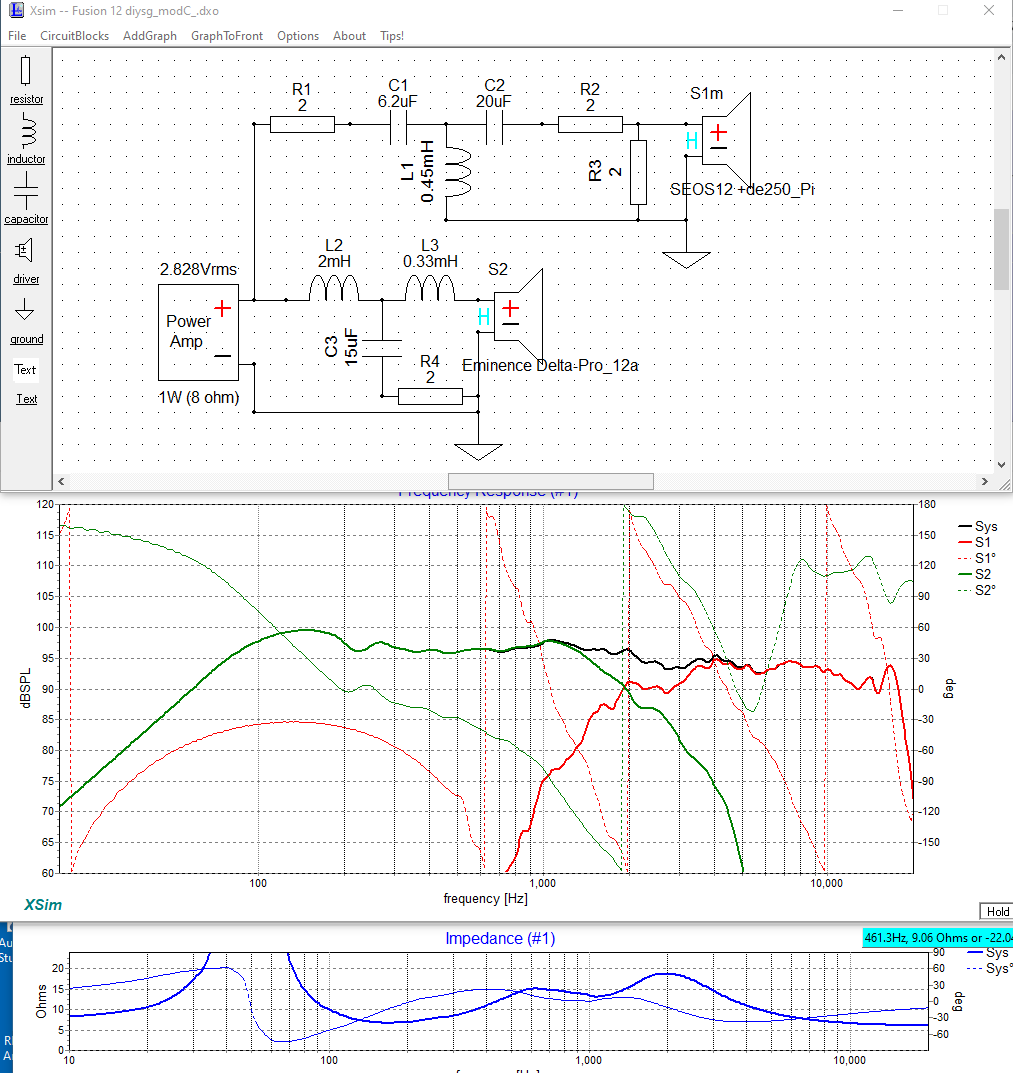
I've also uploaded an XSim file that has a bunch of different drivers on the H6512 horn ( for you to play with ).
Some of the responses were created with my own drivers while some are traces or files from other contributors within this thread.
The upshot here is that to use the H6512 is quite doable ( one will just need to be creative in the crossover design ).
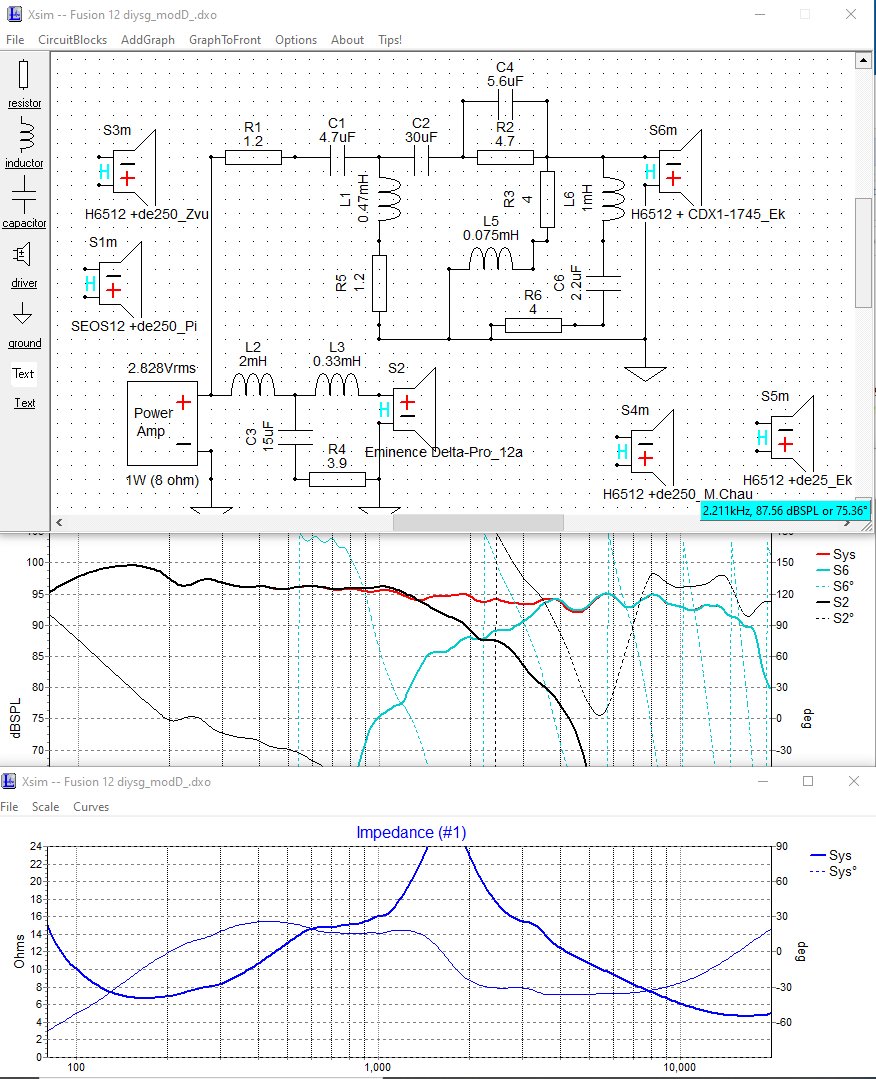
Within XSim, simply swap in one HF driver for another ( drag + drop ).
Then play with all the included passive elements ( some are needed while some aren't >> it all depends on which HF driver is being used ).
- "Right-Click" on any passive to either Engage it ( Normal ) , Short it out , or Open it ( break the circuit ) .
- Clearly Jeffs network design was the core beginning to what I've posted ( I just had to add in a couple "Kitchen Sinks" to tame the H6512's ripples.
Have Fun!
🙂
Okay , here ya go ( plus bonus frds + zmas for the small Peerless driver and an Altec 802-8T ) all measured on the H290B BiRadial ).
This is an XSim file ( with the frds + zmas embedded ) from an Altec project that I'm currently involved with ( the file location waylaid me ).
Download the XSim exe > open my attached file ( within a newly created folder that you are confident that know the location of ) > Save the file > Close XSim and upon closing, the XSim software will create a new "DATA folder for frd + zma files" and has extracted ( + placed ) all the frd's + zma's used in the original .dxo ( XSim ) file into that new folder .
I would recommend against the ECM8000 and instead suggest you get a calibrated Dayton EMM-6 from Cross Spectrum Labs .
- One wants a calibration file that's recognized as being accurate ( which leaves out the Behringer ).
Also, You really ought to be studying the designs + words of the late Jeff Bagby ( RIP ).
He designed the "Tempest" Fusion12 and the Zepher for DIYSG using Eminence 12" woofers.
- His observations on both those designs are words ( that I feel ) one can take to the bank.
- Your rush to order the Eminence 3012LF is a bit hasty and premature ( IMHO ).
- One eWaver ( over at AK ) who has both the 3012HO and 3012LF ended up preferring ( by a far margin ) the mids of the HO over those of the 3012LF.
For him it was a matter of choosing his poison.
- JeffB's compromise ( with the Delta Pro 12a seems a better way forward from my perspective ).
Read Jeff's Words Here!
The crossover workings of the "Tempest ( Fusion12 ) " was recently unraveled HERE!
I've also uploaded an XSim file that has a bunch of different drivers on the H6512 horn ( for you to play with ).
Some of the responses were created with my own drivers while some are traces or files from other contributors within this thread.
The upshot here is that to use the H6512 is quite doable ( one will just need to be creative in the crossover design ).
Within XSim, simply swap in one HF driver for another ( drag + drop ).
Then play with all the included passive elements ( some are needed while some aren't >> it all depends on which HF driver is being used ).
- "Right-Click" on any passive to either Engage it ( Normal ) , Short it out , or Open it ( break the circuit ) .
- Clearly Jeffs network design was the core beginning to what I've posted ( I just had to add in a couple "Kitchen Sinks" to tame the H6512's ripples.
Have Fun!
🙂
Attachments
Last edited:
Hi, that's me. I wanted to start.- Your rush to order the Eminence 3012LF is a bit hasty and premature ( IMHO ).
Thank you for the data, much appreciated! As for the microphone: My budget is already stretched so much (and there will besome, I know ...), I do not know if I can spend another 100 euro on a mic alone. Couldn't find a calibrated Dayton here in Germany, the Behringer costs 99 calibrated.
I was raised with a violoncello, learned about Schönberg and Steve Reich in school, but my last musical renaissance, already years ago now, was with experimental electronic music in the underground clubs. I also love rock, but I also love that which Simon Reynolds once coined the hardcore continuum. The Wire 300: Simon Reynolds on the Hardcore Continuum: Introduction
- The Wire I do not want to reproduce the soundsystem culture in my room, it belongs in the club or on the field, and I do not have this music in mind primarily, I listen to any kind of music, as long as it is good (and nicely reproduced by a soundsystem). Yet, I do think about what kind of bass extension I need. I want a full range system which isn't too shallow at the bottom end, and I do not see a sub in my room. I also understand the value of a good mid frequency definition for presence and I was frightened already, as you may have read, that the problems with the cone breakup of the 3012LF might not be erased from its sound profile. So I appreciate your suggestion with the Delta Pro 12A, but what will its low end sound like in a box of 2 cu. feet? The Faital Pro 12PR320 also models nicely, even though its cone surface is way less than the Eminence drivers. How do they compare?
Last edited:
I ordered a pair of H290B from parts express and sent back the 3012LF for now. So now, I have the essential waveguide and bought myself time to take it more easy and relaxed with driver choice and the build in general.
I spend some time on the woofers. People who used the 3012LF and the Faital 12PR320 in bass guitar speakers described the latter as 'more open', which might be a result of the smoother midrange response when played full range. Down low, they perform equally linear. So I began to wonder what makes the midrange of the 3012HO or other woofers more delightful. Is it maybe even not the woofer itself, but a matter of where you cross to the CD? I find it hard to find any reliable magnitudes for midrange quality. If I will cross around 1,1 kHz, what will I look for then?- One eWaver ( over at AK ) who has both the 3012HO and 3012LF ended up preferring ( by a far margin ) the mids of the HO over those of the 3012LF.
🙂
By now, I am more irritated than ever: the performance of a 12" woofer in the upper midrange is not held in high opinion at all. Neither Troels, who based a speaker design on the Faital Pro 12PR320, but crossed it really low, nor the participants in this forum seem to think it is a good idea: https://www.diyaudio.com/forums/mul...m-spl-low-distortion-2-a-612.html#post6256715
So what should one think at all about the 2-way 12"-woofer + waveguided CD design?
So what should one think at all about the 2-way 12"-woofer + waveguided CD design?
Last edited:
- Home
- Loudspeakers
- Multi-Way
- B&C DE-250 FRD & ZMA questions
